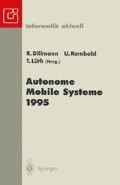Zusammenfassung
Im Rahmen der Entwicklung autonomer Robotersysteme besteht eine wichtige Aufgabe der Forschung darin, die Abhängigkeit von a priori Wissen zu reduzieren und dieses durch Sensordaten, welche automatisch und problemorientiert gewonnen werden, zu ersetzen. Wenngleich bereits viele damit in Zusammenhang stehende Aspekte untersucht wurden, so blieb das Problem der systematischen Durchführung von Messungen zur Erzeugung eines Umweltmodelles meist vernachlässigt.
In diesem Beitrag stellen wir einen allgemeinen Ansatz zur gezielten und effizienten Vermessung einer unbekannten Umwelt vor. Grundlage unseres Verfahrens bilden Bewertimgsfunktionen, welche im Konfigurationsraum des Roboters definiert werden. Basierend auf dem aktuellen Wissen über die Umwelt und auf Randbedingungen hinsichtlich der Roboterbewegungen geben sie ein Maß für die Eignung von Konfigurationen für eine Messung. Durch Verwendung hoch bewerteter Konfigurationen wird eine schnelle, effiziente Erkundung der Umwelt erreicht. Das Verfahren eignet sich für Roboterarchitekturen verschiedenster Art, z.B. mobile Systeme oder auch Manipulatoren mit vielen Freiheitsgraden und Redundanzen; die inverse Kinematik des Roboters muß nicht bekannt sein. Von den zu verwendenden Sensoren wird vorausgesetzt, daß sie Tiefenmessungen liefern, wie z.B. Laserscanner, Stereo Systeme oder Sonar.
Access this chapter
Tax calculation will be finalised at checkout
Purchases are for personal use only
Preview
Unable to display preview. Download preview PDF.
Literatur
N. Ayache and O. D. Faugeras. Maintaining representations of the environment of a mobile robot. IEEE Transactions on Robotics and Automation, 5 (6): 804–819, Dec. 1989.
J. Barraquand, B. Langlois, and J.-C. Latombe. Numerical potential field techniques for robot path planning. IEEE Transactions on Systems, Man, and Cybernetics, 22 (2), Mar. 1992.
J. Barraquand and J.-C. Latombe. Robot motion planning: A distributed approach. The International Journal of Robotics Research, 10 (6), Dec. 1991.
A. Elfes. Occupancy grids: A stochastic spatial representation for active robot perception. Proceedings of the Sixth Conference on Uncertainty in AI, July 1990.
A. Elfes. Dynamic control of robot perception using multi-property inference grids. In IEEE International Conference on Robotics and Automation, pages 2561–2567, 1992.
L. Kavraki and J.-C. Latombe. Randomized preprocessing of configuration space for path planning: Articulated robots. In IEEE/RSJ International Conference on Intelligent Robots and Systems, pages 1764–1771, 1994.
J. Leonard, H. F. Durrant-Whyte, and I. J. Cox. Dynamic map building for an autonomous mobile robot. The International Journal of Robotics Research, 11 (4): 286–298, Aug. 1992.
R. C. Luo and M. G. Kay. Multisensor integration and fusion in intelligent systems. IEEE Transactions on Systems, Man, and Cybernetics, 19 (5): 901–931, Sept. 1989.
L. Matthies and A. Elfes. Integration of sonar and stereo range data using a grid-based representation. In IEEE International Conference on Robotics and Automation, pages 727–733, 1988.
T. Stahs and F. M. Wahl. Fast and versatile range data acquisition in a robot work cell. In IEEE/RSJ International Conference on Intelligent Robots and Systems, pages 1169–1174, July 1992.
E. R. Stuck et al. Map updating and path planning for real-time mobile robot navigation. In IEEE/RSJ International Conference on Intelligent Robots and Systems, pages 753–760, 1994.
Z. Zhang and O. Faugeras. A 3d world model builder with a mobile robot. The International Journal of Robotics Research, 11 (4): 269–285, Aug. 1992.
Author information
Authors and Affiliations
Editor information
Editors and Affiliations
Rights and permissions
Copyright information
© 1995 Springer-Verlag Berlin Heidelberg
About this paper
Cite this paper
Kruse, E., Gutsche, R., Wahl, F.M. (1995). Inkrementelle sensorbasierte Erzeugung eines Umweltmodelles mit Hilfe von Bewertungsfunktionen im Konfigurationsraum. In: Dillmann, R., Rembold, U., Lüth, T. (eds) Autonome Mobile Systeme 1995. Informatik aktuell. Springer, Berlin, Heidelberg. https://doi.org/10.1007/978-3-642-80064-1_13
Download citation
DOI: https://doi.org/10.1007/978-3-642-80064-1_13
Publisher Name: Springer, Berlin, Heidelberg
Print ISBN: 978-3-540-60657-4
Online ISBN: 978-3-642-80064-1
eBook Packages: Springer Book Archive

